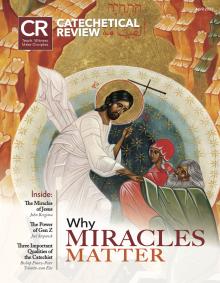In 1583, nearing the end of a brilliant career as a painter, sixty-five-year-old Jacopo Robusti began work on The Annunciation, a scene of Gabriel announcing to Mary that she would be the mother of Jesus, the Son of God. Having grown up in his father’s dye business, Jacopo Robusti was better known as Tintoretto, the “little dyer,” from having drawn on the walls of the shop with pigments from his father’s dye pots. After absorbing the drawing style of Michelangelo and the color sense of Titian, he established a career in Venice. Tintoretto belonged to the group of Venetian painters known as Mannerists. Mannerism is a style characterized by exaggerations and unusual uses of color, light, and movement. As a mature painter, he also became known as Il Furioso—“The Furious”—for his energetic brushwork and powerful compositions, such as Paradise, an eighty-foot-long painting that is claimed to be the largest image ever painted on canvas. On a more moderate scale (13x17 feet!), Tintoretto’s The Annunciation is an example of how an artist can take what is conventionally seen as a quiet moment and turn it into a cosmic event. Tintoretto imaginatively, and correctly, transforms a well-known passage from Scripture into an exciting visual drama worthy of deep contemplation.
In the Gospel narrative, we are not given details of what Mary’s room in Nazareth was like, nor what Joseph was doing at the moment of the arrival of the Archangel Gabriel. Tintoretto gives us a significantly original point of view in which we see much more of the environment than expected. The side of the building facing us, the “fourth wall,” has been removed, which allows a broad expanse of space to be revealed. We get an “inside/outside” view of this moment and, at the same time, a vision of a needful world about to be transformed. Outside the house, the environment is dark, filled with broken boards in jumbled piles.
We can imagine this place as unkempt and disordered, a house and landscape that once was whole but now has fallen apart. This is a beautiful metaphor for the world as it was after the Fall of Adam and Eve. St. Joseph is in the distance working at some project alone in the darkness. The wall that separates the outside from the inside is itself a ruin of broken architecture. Mortar is peeling away from the brick wall. A piece of a classical column is topped with fragments of stones, bricks, and pottery—a haphazard stack of human designs that represent the failure of mankind to accomplish a true, beautiful, and lasting order. Mary’s room is tidy but also shows material poverty. The seat of the empty chair needs repair, and while the checkerboard of the floor depicts the order of classical perspective, it isshowing age and wear. But there is a glimmer of light on the horizon. Something is about to change—restoration and salvation are at hand. Christ will make all things new again.
The rest of this online article is available for current Guild members.
This article is from The Catechetical Review (Online Edition ISSN 2379-6324) and may be copied for catechetical purposes only. It may not be reprinted in another published work without the permission of The Catechetical Review by contacting [email protected]

















